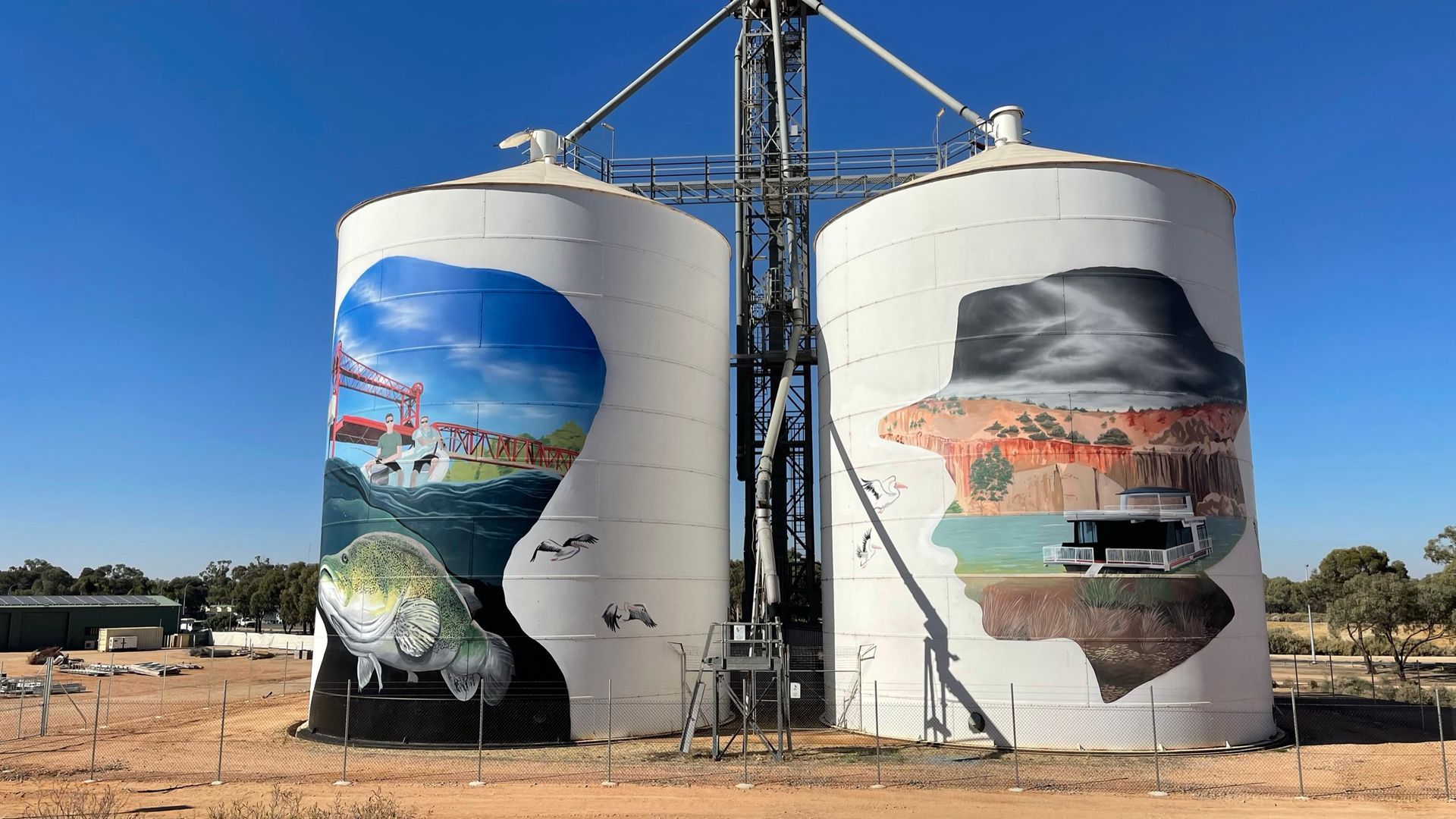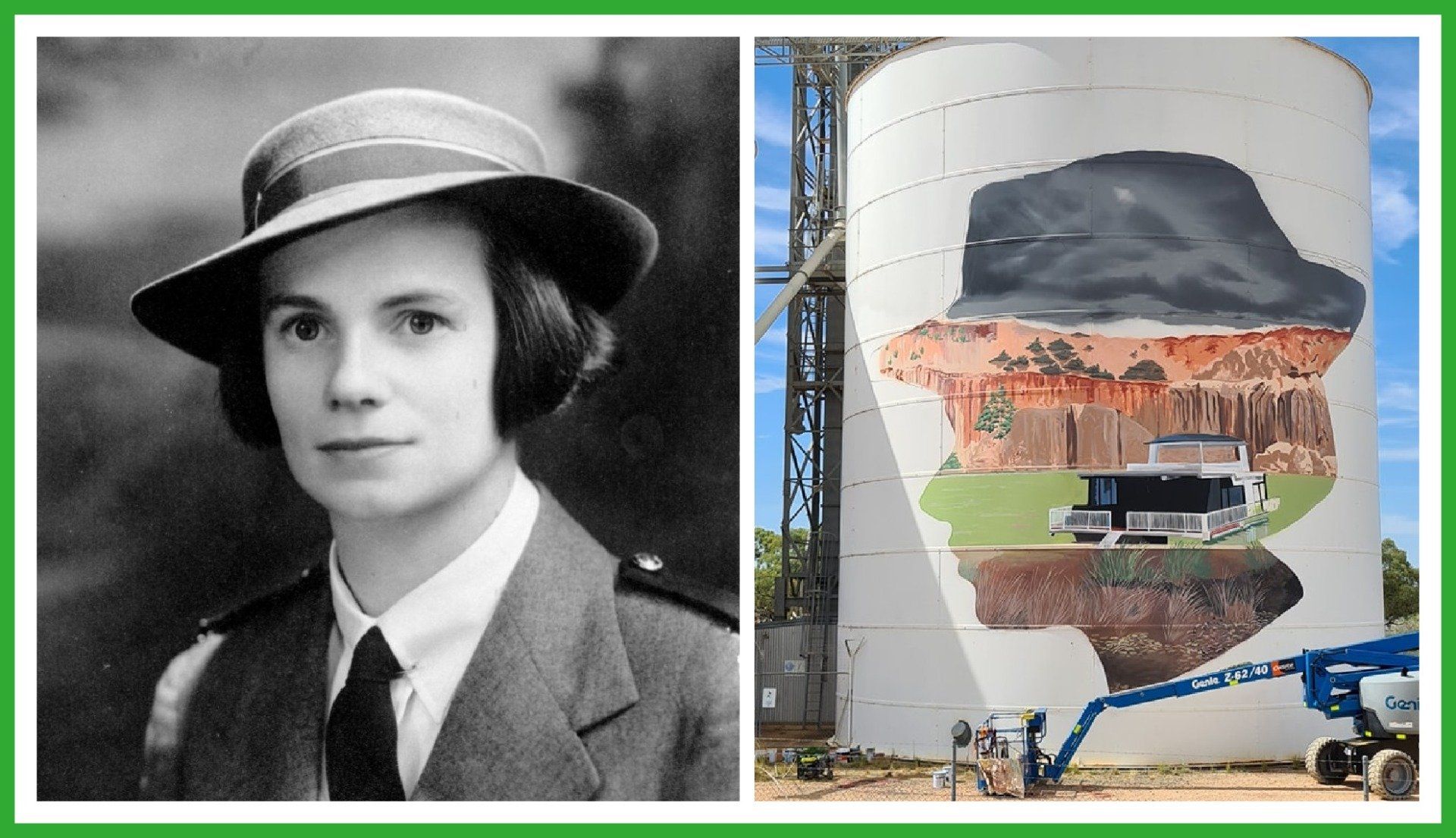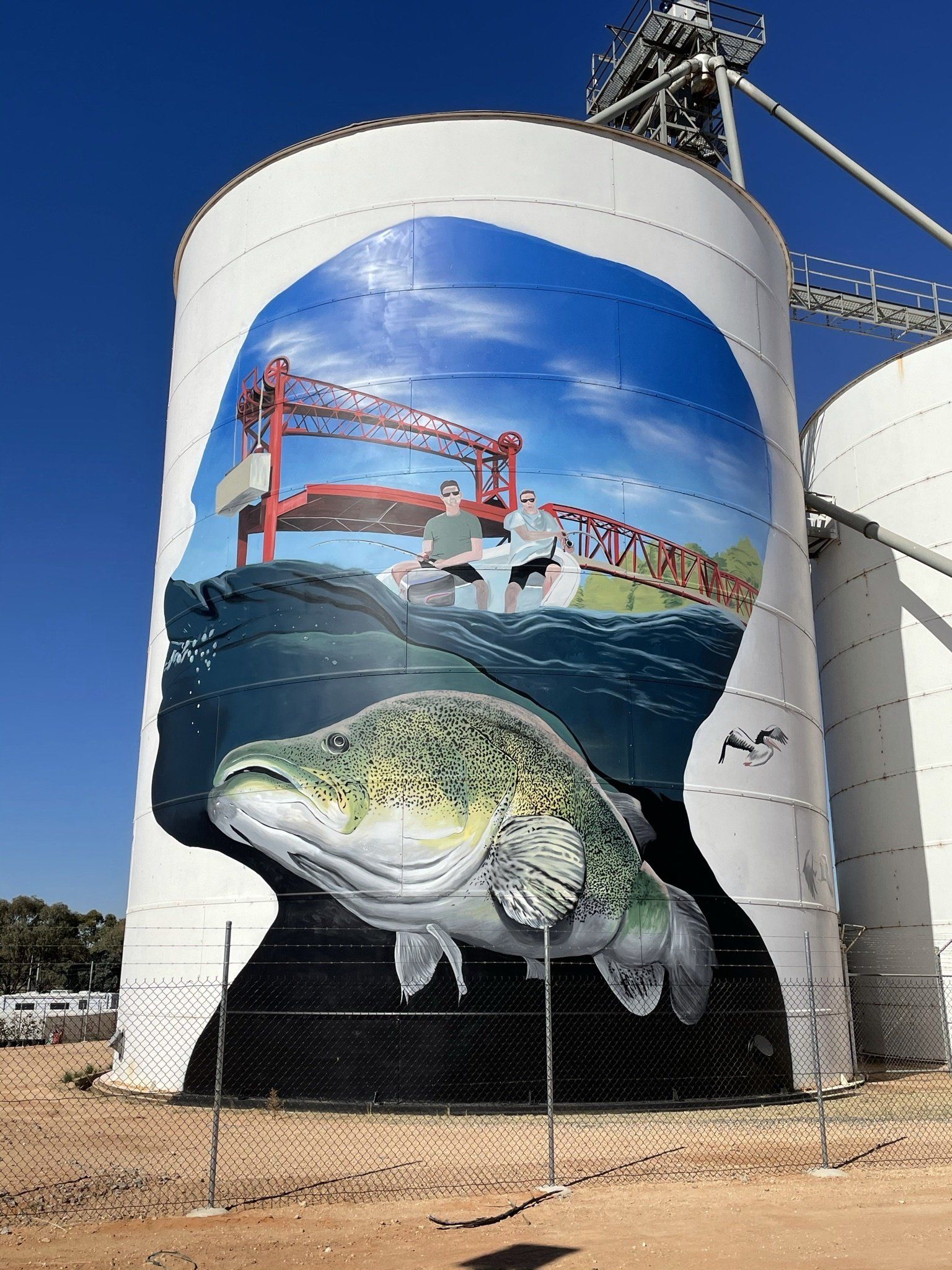
Photo by: ASAT
Paringa Silo Art - South Australia
Artists: Jack Fran & Sam Brooks
Location: Silo Road, Paringa, SA
Video by: @SlowLowRider
CHARLES FRANCIS CHAFFEY 1859-1938
The concept of irrigation was introduced to Australia in 1887 by Canadian brothers George and William Chaffey, following on from their successful irrigation venture in California USA.
Charles Chaffey was summoned in 1888 by his older brothers to take charge of the new Renmark settlement. Charles had married Margaret (Ella) English in 1886 and left her and young son in California while he went to SA to inspect his brothers' latest business venture.
He then left plans for a new home with former shipwright/carpenter A.F. Matulick and returned to the USA to bring his wife and child to Renmark. Ella remained in Adelaide after their arrival, giving birth to a second son before travelling in January 1889 to Renmark.
Their new home was not completed and the family resided in the Paringa Station homestead until the last months of 1889.
Charles worked from the Chaffey offices in Murray Avenue and would meet new arrivals and arrange land sales and finance. When the Chaffey's operation was liquidated in 1895 during a decade of drought, recession and no capital for irrigation infrastructure, many settlers chose to leave their fruit blocks when unable to repay mortgages.
Charles was employed by the Melbourne based mortgagor to collect payments from the remaining settlers. The Chaffey homestead "Olivewood" was visited by many politicians and high ranking clergy and the couple were highly regarded in Renmark.
In 1904 Charles, Ella and their six children left Renmark to visit British Columbia, Canada and in their absence the mortgage on the "Olivewood Estate" was foreclosed.
"Olivewood" homestead and orchards on Renmark Avenue are owned by National Trust SA. The Chaffey name is present in a local theatre, school, community centre, irrigation district and museum.
DAVID JAMES JONES a.k.a. "POSSUM"
David James Jones born in 1901 at Ruapuna, South Island New Zealand was one of two children of sheep farmer James and Helen Jones (nee Crump). He came to South Australia in 1924 where he found employment shearing in the mid north and far north of the state. In 1928 his Australian Workers Union ticket had expired and in 1929 during the Depression he was turned away from the shearing shed at Lake Victoria Station in NSW.
Too proud to borrow money he walked into the bush and remained there for over 50 years until his remains were discovered by woodcutters in 1982 near Lock 8.
Living off the land he roamed the Murray River mainly between Renmark and Wentworth....... but there were sightings of him in the 1930's and 1940's as far as Bourke on the Darling, Wagga on the Murrumbidgee and Albury on the Murray.
Shy and resourceful he shunned the company of others but many were the acts of kindness - mending fences, chopping wood, clearing noxious weeds and crutching flyblown sheep - that he performed unobserved for the station folk on whose properties he passed through.
His nickname "Possum" came about from his habit of taking refuge by climbing trees where he had 'hides' for sleeping and where he was fond of raiding wild bee hives for honey.
He was buried 60km from Renmark on Lucerne Day Station (formerly Wangumma) in NSW and his gravestone carries an apt epitaph At Rest Where He Roamed.
CAPTAIN PEARL WALLACE 1911-2005
Pearl Royal Collins was born in 1911 in Renmark. Her father William and brothers Norm and Bill were well-known shipwrights and captains. Her early years were on the steamer "Alpha" as the family traded their wares along the Darling. In the wheelhouse she had her first school lessons with her father, who also taught her about the river.
In 1919 the family returned to Renmark and transported supplies to new soldier settlement areas. They delivered firewood to the Renmark pumping stations and materials for the construction of Locks 5 and 6. In 1931 Pearl married Neil Wallace, an engineer at Lock 8, where they lived in a hessian house, with kerosene box chairs and a carpet made from flour bags.
In 1947, Pearl travelled to Melbourne with Neil and their 10 year old son Leith to sit for a River Master's Certificate. After an intensive three day exam, the strict examiners said "You are as good as any man we have put through and better than some", and Pearl became Australia's first female certified skipper.
In 1948 Pearl was given the PS "Kookaburra" by her father, which she operated with Neil. Taking what contracts they could find, they carted firewood to Berri pumping station from the flooded Pike River. At the height of the 1956 flood she was at the helm of the Vega barge loaded with a huge cargo of wool on the Darling River towed by PS "Success". Later, after overhauling the "Kookaburra" herself, Pearl worked at Murray Bridge, clearing the irrigation sluices after the 1956 flood. Here she met the author Nancy Cato, who subsequently wrote "All the Rivers Run", inspired by Pearl's life. This river romance became a popular television mini-series filmed at Echuca.
Pearl's last job on the river was in 1977 as skipper on the pleasure cruiser "Canberra" at Echuca, before she retired to her home at Balhannah in the Adelaide Hills. The home's nameplate read "Alpha".
Captain Pearl Wallace was a regular attendee at the Murray Skippers Association to which she was awarded Life Membership. In 2005 Pearl passed away peacefully, aged 94.
Pearl Wallace is pictured with Alan Smith at a Murray Skippers Association function in 1991 representing a transition of riverboat captain eras. Alan, a Paringa resident with his wife Davia successfully operated the ‘MV (Motor Vessel) Barrangul’ a cruise boat and floating restaurant in the Riverland from 1976 to 1986. He then relieved on boats such as PS Pyap, Oscar W and MV Proud Mary until 1992 when he became captain of the PS Industry until his retirement in 2018. Alan instigated the Murray Skippers Association in 1988 and was president for 16 years.
PS INDUSTRY
The P.S. (Paddle Steamer) Industry built in Goolwa, commissioned in January 1911 as a workboat for the S.A. Engineering and Water Supply Department spent her working life keeping the river open for navigation by removing snags and in the construction of locks weirs and barrages. When the larger locomotive style "Perry" boiler was installed in 1933 she boasted the largest boiler on a River Murray steamer.
During the 1956 flood she "stood by" with steam up ready for an emergency total evacuation of Renmark which appeared imminent.
The P.S. Industry was decommissioned in 1969 after 58 years of service. A submission backed by 100 guarantors by the Corporation of the town of Renmark presented to the Premier, Hon. Don Dunstan saw the steamer allocated to the town for preservation as a Historic Museum. A basin was excavated to house her where she opened as a static museum in 1975.
A submission from the Apex Club of Renmark for restoration to full steam working resulted in a public meeting to gauge support for the project. Through this meeting a Friends of the P.S. Industry was formed in 1990 to oversee the restoration.
Following the long awaited restoration to full steam working the P.S. Industry starred as the Lady Mabel in the television series, 'The River Kings'. She has since travelled extensively along the river visiting ports from Mildura to Goolwa. In 1977 she participated in P.S. Marion's 100th birthday celebrations where she won the first and only organised paddle steamer race.
Extensive work aided by an interest-free S.A. government loan enabled the P.S. Industry to be registered as an historic passenger carrying vessel. She was recommissioned by Transport Minister Ms Diana Laidlaw on the 16th of July 1995.
April 2nd 2011 saw the P.S. Industry celebrate her 100th Birthday supported by many boats from all along the River.
It will be largely, thanks to the efforts of the dedicated "Friends of the P.S Industry", volunteers & community sponsors that the P.S. Industry will remain able to be enjoyed by future generations.
GEORGE DISHER 1883-1953
Murray Pioneer editor Arch Grosvenor described George Disher as "not only a local identity. He was a local institution". So it was only fitting that in 1936 for Renmark's celebrations for the State Centenary, Renmark's popular indigenous local was chosen as the subject of a button struck to raise funds for the occasion.
George was a good-natured favourite with locals and tourists for whom he would offer (for 2 shillings) to write and date a sentence backwards. This could then be read by holding the message in front of a mirror.
George was born in 1883 at Raukkan (formerly Point McLeay mission) and when aged 20 married Una Hodgekiss aged 18 in 1903 at the mission church. In 1924 George and wife Una had been living in Berri for seven years, when their 14-year-old son Richard (Dickie) died as the result of double pneumonia. Dickie had been one of the earliest coxswains of the Berri Rowing Club and was an exceptionally good swimmer and member of the Boy Scouts.
George was a proud man, accepting any work when it was available, whether in a packing shed, as paddlesteamer crewman, shearing or donning a sandwich board to advertise products or films. Una Disher aged 46 died in 1930 and is buried in the Renmark Cemetery.
In 1941 on "Aborigine Sunday" from the pulpit of the Renmark Congregational Church, the astute Rev. H.R. Ballard said of George Disher: "Many of us accept George Disher without any thought of the meaning of his life in our midst. How many of us, if we were situated, practically isolated from the rest of his race, living a life alone, would maintain such a cheerful outlook on life meeting each day with a smile? I tell you that man has much to teach us and we will be well advised to learn his lessons if we hope to be worthy of this country which we have taken from his ancestors".
George Disher died in 1953 aged 70 years in Buronga NSW.

SISTER ELAINE BALFOUR-OGILVY 1912-1942
Elaine Balfour-Ogilvy was born in 1912 in Renmark, one of five children of Harry L.S. Balfour-Ogilvy (veteran of the Boer War and WW1) and Jane Keyes, a teacher at Renmark Primary School prior to her marriage. After receiving her education in Renmark and Adelaide, Elaine began her nursing training in the Adelaide Children's Hospital and in 1940 enlisted in the A.I.F. as a Sister in the Australian Imperial Nursing Service. In 1941 she embarked for overseas service.
In Singapore she was a member of the 2/4th Casualty Clearing Station tending thousands of casualties during heavy shelling and bombing until the Japanese occupation of Singapore looked inevitable.
Sister Balfour-Ogilvy and other nurses and civilians boarded a coastal vessel, the Vyner Brooke which became separated from its convoy. The Japanese attacked the steamer on February 14, 1942 when it was ten miles off shore from the village of Muntok in the Banka Straits. Elaine was one of twenty-two nurses and a number of civilians who made it to shore in a leaky lifeboat.
Once ashore the civilians walked to the village of Muntok while the nurses stayed to look after the wounded. On February 16 they were found by a party of Japanese soldiers who told them in sign language to form a line including the wounded and walk into the sea; they were machine-gunned from behind. This tragic event became known as the Banka Straits Massacre. An annual Bangka Day Memorial Service on the Sunday nearest to the 16th February. This service is to honour and remember women who served and those who made the supreme sacrifice for our country from the Navy, Army and Air Force.
Elaine's life is inspirational and her memory is commemorated by schools in the form of an amenities room, honour board and scholarship in addition to a Loxton street and the Renmark Children's Library.
HOME OF THE FIRST HOUSEBOAT
In 1961 a catamaran was developed by F. Ian Showell of Renmark and Michael Kempe of Lindsay Point (near Paringa), as a tourism venture. Ian Showell was an ideas man and entrepreneur and the seed for this project came from seeing tourist boats (possibly in Egypt on the Nile) during his WWII Airforce service. The proto-type consisted of two steel pontoons filled with a foam material for emergency floatation. Self contained accommodation to accommodate six was built on steel framework. This first boat was powered by Farmall tractor engine to two paddlewheels at the stern.
A year later Ian Showell bought out his partner and over the next 30 years improved on his original design and with his family and dedicated staff developed the Liba-Liba fleet of up-market houseboats to 30. Other people took advantage of the concept and built their own with different designs and drive mechanisms but Liba-Liba stayed with the paddle wheels. In 2021 Libas can still be seen paddling the river 60 years on.
This totally new holiday option revolutionised river focussed tourism in the Murray Darling system and it has become a multi million dollar industry.
Ian Showell OAM died 8 August 2001.
Although called Liba-Liba 2 this is the first boat built in 1961 and the first hire and drive yourself holiday houseboat on the river system






